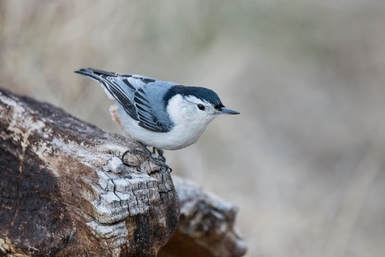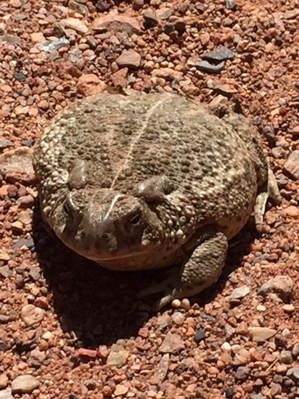 Just now I had a White breasted Nuthatch visiting on the porch railing near the garden wall where I have placed sunflower heads to dry. My guess is that he was curious about the new additions. His little chirps sounded like he was excited about something! The jays have returned and I think they are intimidating the Nuthatch family, so I may put up another feeder closer to the house. White breasted Nuthatches are easy to identify. They are larger than the other nuthatches with a sharply defined white face, a narrow dark crown, and a very long bill. With a short broad tail they are mostly gray and white in color. All summer long I have had them feasting at my bird tree with its squirrel proof feeder. I never tire of watching these spritely little characters climb up and down the branches to take a seed or two before disappearing into the greenery. This year I was fortunate to have witnessed the nuthatches raise a family of four little nuthatches in a tree not very far from the bird tree. This is not a large tree although it has a generous canopy and I will be curious to see where the nest is located when the leaves fall. Most sources say that they nest in tree cavities… so I will have to wait to see. All summer the little ones flew between the nest tree and the bird tree – all day long! When the babies first fledged it took them awhile to figure out how to land on the edges of the feeder. I am delighted to see that the whole family is still here, especially since it is mid September and seeds and grasses of all kinds are available for these little birds to feast upon. Apparently their preference for sunflower seeds has kept them around. Soon, I hope, it will be cool enough to put out suet. As a bird watcher I am a lover of suet and fat because it draws some of my favorite little birds – nuthatches, chickadees, and woodpeckers in for a feast even during the fall. I would like if possible to keep this nuthatch family with me all winter. I love watching them carry away seeds to hide in crevices of trees. White-breasted Nuthatches forage up, down, and sideways over tree trunks and around large branches, which is why it is easy to lose time watching these little birds. They are small aerial acrobats turning upside down with ease to peck suet over their heads. In fact climbing upside down is a distinctive trait of this species. They often start high in trees and move down them head first, pausing to crane their necks up and back, toward the horizontal, for a look around. They probe into bark crevices or chip away at wood to find food. When they find large nuts and seeds, they jam them into the bark and hammer them open. White-breasted Nuthatches often store seeds and insects one at a time, and somewhat haphazardly, under loose bark on their territory. They typically hide the food by covering it with a piece of bark, lichen, moss, or snow depending on where they live. According to the literature they live in pairs year round and chase other nuthatches from their territory. Does this include their offspring? I am curious to see if the family will eventually disperse. Agitated birds fan their tails, flick their wings, or raise their feathers. A bird backing down from a confrontation typically raises its bill and tail, and droops its wings. White-breasted Nuthatches are birds who prefer mature woods, and they’re more often found in deciduous than coniferous forests. They also inhabit woodland edges and in open areas with large trees like the area around my house. They can also be found in parks, wooded suburbs, and yards. During the warmer months they supplement their seed and nut diet with insects, including weevil larvae, wood-boring beetle larvae, other beetles, tree hoppers, scale, ants, gall fly larvae, caterpillars, stinkbugs, and click beetles, as well as spiders. What I didn’t know was that they also eat corn. Their song is distinctive; soft whistling notes with a single pitch. Some sources indicate that their calls vary region by region. What I know from personal experience is that the white breasted nuthatches in Maine sound exactly like the ones in New Mexico. Audubon considers this species climate threatened. It’s important to recognize that drawing these little birds to our feeders helps protect the trees that are infested with damaging insects, so next time you see a White -breasted Nuthatch remember to say thank you for the trees!
4 Comments
 Yesterday morning around 10:30 AM I looked into what had been an empty toad hole that had been dug into the ground on my drip line only to see that someone had filled the tunnel in. Last night I checked the deep depression around dusk and the earth was moving! Returning from an evening dog walk ‘my’ giant Western toad was emerging just before dark. Almost immediately she rounded the corner and disappeared into the vining nasturtium patch... Early last June, I had constructed a rock pool to invite a toad to make a home here in my front yard. Although birds and lizards liked the oasis I never glimpsed a toad until August 29th, a day I will never forget. It was around 2 PM and 92 degrees when I spied a giant Western toad sitting in the middle of my driveway. Stunned, I went over to investigate. In three long hops the female (females are larger than males) landed on the only ground that was moist, irrigated, and had ample space for a toad of her size – she was 5 1/2 inches long and almost as wide. Immediately she dug herself into the still moist soil scattering a few seedlings as she began to disappear before my very anxious eyes. I knew that Western toads couldn’t survive in 92 degree heat and wondered who had frightened her so badly that she ended up exposed to the merciless sun. When she was about two thirds submerged, she just stopped, seemingly, in exhaustion. At this point I intervened and gently poured about six cups of water around her. Her amber eyes peered into mine; I’m quite certain she knew I was trying to help. Next I cut Russian olive and cottonwood leaves to cover her head, and finally placed a big piece of cottonwood bark over the entire spot to keep her cool. That night when I went out to check on her she was gone. The most amazing part of this story for me is that it was obvious that my toad knew exactly where to go to get out of the sun as fast as she could. The spot she chose was the only place in this whole area that was not root bound with perennials. It gradually dawned on me that this toad had probably been living here all summer, and I had just made her acquaintance! I was thrilled because the one thing I miss the most about the Northeast is living with an abundance of toads and frogs in a rich riparian woodland. Over a period of thirty years I have probably raised thousands of peepers, wood frogs, and American toads from eggs that I collected each spring, even after building an ‘almost vernal pool’ to provide more inviting territory beside my brook. This shallow depression, about 100 feet in length is fed by a natural spring, and everyone including a Great Blue heron loved it! When I first moved down by the river in Abiquiu I was sure that I would see and hear toads and frogs in the spring, but I was wrong. In two years I have heard only one toad call. This spring I looked forward to the summer rains that would bring out the amphibians I waited for with child-like anticipation… but this monsoon season has brought so little rain that there were no puddles that lasted long enough for mating to occur or eggs to be laid. By now I also had learned from direct observation that the river’s damming process made it nearly impossible for amphibians to rely on these unstable waters for places to breed because during the summer the river rises and falls constantly. When my giant Western toad made her astonishing appearance I immediately dove into some extensive research on this toad who is the western version of the America toad that I am so familiar with. I was devastated to learn that according to a number of academic sources this animal is already extinct in the only area in which the Western toad once thrived in New Mexico, the Rio Grande and its tributaries in Rio Arriba county. The welcome appearance of my toad indicates that as yet the species is still extant, but probably not for long. Toads and frogs have been under siege since the early 70’s when ecologists and naturalists first starting writing about their diminishing numbers, something that I intuited from direct observation before beginning to read about these ‘canaries in the coal mine.’ All amphibians as adults breathe through their skin and environmental toxins were already polluting our air and water as Rachel Carson tried to inform us in her ground - breaking book “Silent Spring.” As Carson, and later, many others predicted, and were ridiculed (I know I was) environmental disaster is now reality - today we are living the consequences of not paying attention to these warnings about the health of our planet. At this point there is little left to do except to accept what is. For me the loss of toads and frogs is deeply personal and heartbreaking because I have loved them all my life. The one antidote to this despair is to take the deepest pleasure out of having a toad living in my yard now and this I am doing on a daily basis. I am heartened whenever I am fortunate enough to get a glimpse of Toad because I know by her size that she has lived a long time (toads live in the wild for ten or twelve years). I don’t know if this toad will continue to use her burrow in my seedlings but just knowing that she seems to be healthy and thriving is a gift that I will treasure for the rest of my days. |
Submit your ideas for local feature articles
Profiles Gardening Recipes Observations Birding Essays Hiking AuthorsYou! Archives
October 2025
Categories
All
|
 RSS Feed
RSS Feed